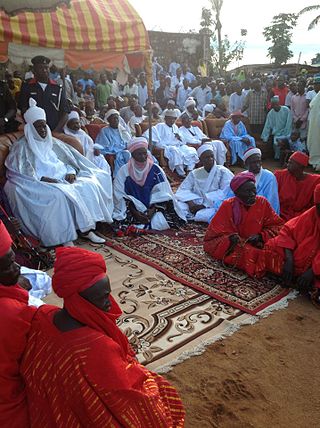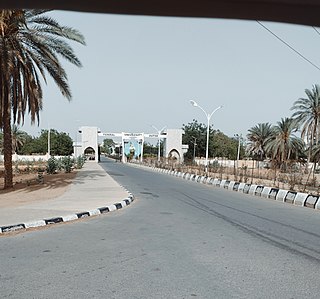Related Research Articles
Jalaa, also known as Cèntûm, Centúúm or Cen Tuum, is an extinct language of northeastern Nigeria, of uncertain origins, apparently a language isolate. The Jalabe speak the Bwilim dialect of the Dikaka language. It is possible that some remembered words have been retained for religious ceremonies, but in 1992 only a few elders remember words that their parents had used, and by 2010 there may not even remain any such rememberers.
The Adamawa languages are a putative family of 80–90 languages scattered across the Adamawa Plateau in central Africa, in Nigeria, Cameroon, Central African Republic, and Chad, spoken altogether by only one and a half million people. Joseph Greenberg classified them as one branch of the Adamawa–Ubangi family of Niger–Congo languages. They are among the least studied languages in Africa, and include many endangered languages; by far the largest is Mumuye, with 400,000 speakers. A couple of unclassified languages—notably Laal and Jalaa—are found along the fringes of the Adamawa area.
The Mlomp language, also known as Gulompaay, is spoken in Senegal. It belongs to the Bak branch of the Niger–Congo language family, and is closely related to the Karon language.

Jigawa State (Hausa: Jihar Jigawa is one of the 36 states of Nigeria, located in the northern region of the country. Created in 1991 from the northeastern-most region of Kano State, Jigawa State is located on the border with Nigeria's national border with the Republic of the Niger. The state capital and largest city is Dutse. Jigawa state has 27 local governments

Muri is a town and traditional emirate in Jalingo but covers Karim Lamido LGA ARDO KOLA Yoro, Taraba LGA and others, in northwestern Taraba State, eastern Nigeria, approximately between 9° and 11° 40′ E. and 7° 10′ and 9° 40′ N. The Benue River is nearby, and the portion on the southern bank of the river is watered by streams flowing from the Cameroon region to the Benue. In 1991, the town was estimated to have a population of 56,570. The valley of the Benue has a climate generally unhealthy to Europeans but there are places in the northern part of the province, such as the Fula settlement of Wase on a southern spur of the Murchison hills, where the higher altitude gives an excellent climate.

Senegal is a multilingual country: Ethnologue lists 36 languages, Wolof being the most widely spoken language.
Tera is a Chadic dialect cluster spoken in north-eastern Nigeria in the north and eastern parts of Gombe State and Borno State. Blench (2006) believes Pidlimdi (Hinna) dialect is a separate language.
Jola (Joola) or Diola is a dialect continuum spoken in Senegal, the Gambia, and Guinea-Bissau. It belongs to the Bak branch of the Niger–Congo language family.
The Bambukica.k.a.Trans-Benue or Yungur–Jen languages form a proposed branch of the provisional Savanna languages, a reduced form of the Waja–Jen branch of the old Adamawa languages family. They are spoken in north eastern Nigeria. Their unity is not accepted by Güldemann (2018).
The Tula–Waja, or Tula–Wiyaa languages are a branch of the provisional Savanna languages, closest to Kam (Nyingwom), spoken in northeastern Nigeria. They are spoken primarily in southeastern Gombe State and other neighbouring states.
Balanga is one of the 11 Local Government Areas in Gombe State, Nigeria. It falls under the southern senatorial district of the state. Its administrative headquarters is located in Talasse town. The LGA is surrounded by Yemaltu-Deba LGA to the north, to the south and east by Adamawa state and to the west by Shongom, Kaltungo and Akko LGAs.
Kwah (Kwa), also known as Baa (Bàː), is a Niger–Congo language of uncertain affiliation; the more it has been studied, the more divergent it appears. Joseph Greenberg counted it as one of the Bambukic languages of the Adamawa family. Boyd (1989) assigned it its own branch within Waja–Jen. Kleinewillinghöfer (1996) removed it from Waja–Jen as an independent branch of Adamawa. When Blench (2008) broke up Adamawa, Kwah became a provisional independent branch of his larger Savannas family.
Dadiya is one of the Savanna languages of northeastern Nigeria. They are found in Gombe, Adamawa & Taraba state. The Dadiya people of Gombe State are found in Balanga local government, while those in Adamawa and Taraba are found spread in Lamurde and Karim-Lamido Local government area respectively.
Tso is one of the Savanna languages of eastern Nigeria.
Dikaka or Cham, is one of the Savanna languages of Middle Belt, Nigeria. It is also known as Dijim–Bwilim, after its two dialects, Dijim and Bwilim. A tonal language, it has a whistled register. It is spoken in Gombe and southwestern parts of Adamawa State of Nigeria.
Kamo is a Savannas language of Gombe State, eastern Nigeria. Their original settlement was on Kamo Hill, but it was abandoned as the speakers gradually moved down into the plains during the 20th century.
Tala is a language from the West Chadian branch of the Chadic language family. The language is spoken in the central regions of Nigeria, and had approximately 1000 native speakers in 1993. The language is unwritten.
Yebu is one of the Savanna languages of Kaltungo LGA in Gombe State, northeastern Nigeria.

The Federal University Dutse (FUD), is one of the nine universities created by the Federal Government of Nigeria in 2011.
The Waja people are one of the ethnic groups in Gombe area of Nigeria that were the early inhabitants of the region. They are the least dominant ethnic group in Gombe state. They inhabited the east-southern corner of Gombe state, occupying the present Balanga local government area of the state. The Waja people are the occupants of the Waja district which spread over an area of 330 square miles (850 km2).
References
- ↑ Waja at Ethnologue (18th ed., 2015) (subscription required)
- ↑ Kleinewillinghöfer, Ulrich. 2014. The languages of the Tula – Waja Group. Adamawa Languages Project.